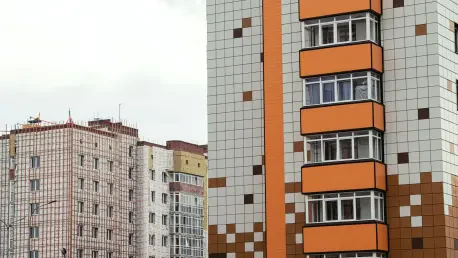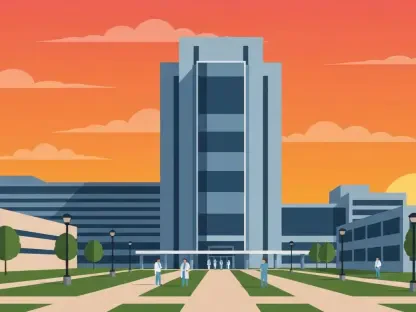In an era marked by increasingly frequent and intense climate-related events, cities across the globe face the daunting challenge of enhancing their resilience to environmental stresses. As urban areas strive to adapt to these shifting conditions, prefabricated green buildings emerge as valuable assets in the pursuit of climate resilience. These innovative structures, which are pre-assembled using sustainable materials and techniques, offer cities a path to not only mitigate immediate environmental impacts but also ensure long-term adaptability and functionality. At the core of this transformative approach is the development of urban environments capable of withstanding, recovering from, and thriving amidst the myriad challenges posed by climate change. Prefabricated green buildings play a crucial role in this dynamic landscape, with their multifaceted contributions to energy efficiency, environmental conservation, and the enhancement of urban ecosystems, positioning them as pivotal components in the architecture of sustainable cities.
Energy Efficiency and Environmental Impact
Prefabricated green buildings are renowned for their energy-efficient designs, which utilize advanced construction methods and materials to significantly reduce energy consumption. These structures are manufactured with precision in controlled factory settings, where features like airtight seals and high-performance insulation are carefully installed, ensuring minimal energy loss. The integration of renewable energy systems, such as solar panels and energy-efficient lighting, further amplifies their efficiency. This commitment to energy conservation is underscored by data from the Modular Building Institute, which indicates that modular constructions can achieve up to 15% greater energy efficiency than traditional buildings. This efficiency is further enhanced by embedded Internet of Things (IoT) sensors that monitor and adapt building conditions in real-time based on occupancy and external factors.
In addition to energy efficiency, prefabricated green buildings make a notable dent in reducing environmental footprints. The prefabrication process substantially minimizes on-site disturbance and waste, leading to a marked reduction in embodied carbon emissions compared to conventional construction methods. Research shows that such methods can cut down emissions by up to 45% due to refined manufacturing processes and reduced material transportation. Precision cutting and recycling of unused materials like steel and wood also contribute to this reduced environmental impact, ensuring that resource usage is as sustainable as possible. Consequently, the life cycle of these buildings maintains a substantially lower greenhouse gas footprint, aligning with broader sustainability goals pivotal to climate resilience strategies.
Enhanced Indoor Environment and Water Conservation
The quality of indoor environments within prefabricated green buildings is another area where these structures excel. Manufacturing in controlled environments allows for stringent quality checks on factors like moisture levels, which effectively reduce common construction errors like leaks and gaps. Moreover, the use of low-volatility organic compounds (low-VOC) materials and sophisticated air-filtration systems significantly improves indoor air quality, a benefit that directly influences occupant health. Proper ventilation systems prevent moisture accumulation, thereby mitigating risks of mold development, structural damage, and health issues.
Water conservation is also a prominent feature of prefabricated green buildings, where innovative technologies are employed to optimize water usage. These buildings often incorporate systems like graywater recycling, rainwater harvesting, and low-flow fixtures, all of which contribute to a substantial reduction in urban water demand. By utilizing decentralized water microgrids, these structures effectively manage and repurpose water, sustaining urban environments through efficient use and minimizing adverse impacts from stormwater runoff during heavy rainfall periods. This resourceful approach not only helps conserve vital water resources but also offers urban areas greater resilience against water scarcity challenges.
Structural Resilience and Urban Ecosystem Integration
Prefabricated green buildings also stand out for their swift construction timelines and exceptional structural resilience. By manufacturing parts off-site while preparing building sites simultaneously, these projects result in shorter overall construction durations. This efficiency minimizes potential weather-related delays and reduces labor costs, while enabling rapid occupancy, which is crucial for emergency applications or post-disaster recovery scenarios. Robust materials used in these constructions, like precision-welded steel frames and impact-resistant cladding, endow them with high resistance to natural disasters, including earthquakes and floods. Damaged modules can be swiftly replaced, ensuring minimal downtime and sustained functionality in the face of environmental threats.
Beyond their structural benefits, these buildings play a significant role in reinvigorating urban ecosystems, integrating elements like rooftop gardens, pollinator habitats, and living walls. Such features contribute to the cooling of cityscapes, provide essential habitats for urban wildlife, and enhance the survival of native plant species. This blend of built environment and natural habitat not only supports urban biodiversity but also fosters ecological balance, further reinforcing the resilience of urban areas against climate-induced disruptions. The incorporation of these natural elements into the urban fabric enhances overall city livability by creating lush, green spaces that benefit both the environment and city dwellers.
Conclusion
In today’s world, where climate-related events are becoming more frequent and severe, cities globally are challenged to boost their resilience against environmental stressors. Urban areas endeavoring to keep up with these changes increasingly see prefabricated green buildings as key assets in achieving climate resilience. These forward-thinking structures, constructed in advance with eco-friendly materials and methods, provide cities with a means to reduce immediate environmental impacts while also ensuring long-term adaptability and utility. The essence of this innovative strategy is to cultivate urban settings capable of enduring, recovering from, and flourishing despite the diverse challenges of climate change. Prefabricated green buildings significantly contribute to this evolving urban landscape with their diverse impact on energy efficiency, environmental protection, and the enhancement of urban ecosystems. These factors position them as essential elements in the creation of sustainable cities that are better prepared for the future.









